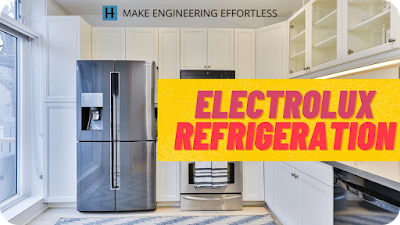Electrolux refrigeration is one type of vapor absorption refrigeration system. It is also called Domestic Eloctolux refrigeration which
works on three fluids absorption system. The fluids are Refrigerant, a Solvent,
and an Inert gas.
- Ammonia as a refrigerant.
- Water as an absorbent.
- Hydrogen as a pumping agent.
Construction
Electrolux refrigeration consists of a generator, rectifier or water separator, condenser, evaporator, absorber, heat exchanger.
Generator:
The generator is the place where ammonia and water mixture (strong solution) gets heated by an external heat source like a gas burner. The temperature of the mixture increases and it is converted into a vapor mixture. The vapor mixture leaves the generator at high pressure.Rectifier:
It is used to prevent the freezing of water vapor in the refrigerating line. The vapor from the generator contains both ammonia and water vapor. When water vapor is allowed to pass through the condenser it gets freezes and blocks the whole refrigerating line. So the removal of the water vapor is done in the rectifier.Condenser:
It is a heat exchanger in which the vapor refrigerant from the generator losses its heat to the circulating cooling water or atmospheric air. By losing heat in the condenser, vapor refrigerant is converted into liquid refrigerant.Evaporator:
Evaporator is the refrigerating space where products to be cooled are placed inside it. The liquid refrigerant gets mixed with hydrogen coming out from the absorber. The mixture of hydrogen and ammonia is passed through the evaporator coils and hydrogen allows ammonia to evaporate at a faster rate.Absorber:
It is a container in which water and hydrogen are present. The hydrogen and ammonia mixture from the evaporator passes through the absorber where ammonia gets absorbed by the water and the hydrogen floats at the top and again recirculates to the evaporator.Heat Exchanger:
The strong solution from the absorber is passed through the heat exchanger where it is pre-heated by the hot weak solution left in the generator. This increases the performance of the system and accelerates the absorption rate.Working principle
- Refrigerant
ammonia is circulated in the high-pressure side of the system. Strong solution of ammonia dissolved in water is heated in the generator. Here ammonia vapor is liberated and flows up to the condenser through the water separator or rectifier.
- Ammonia
vapor is condensed in the condenser at constant pressure.
- The
liquid refrigerant leaves the condenser and joins the stream of hydrogen
coming from the absorber.
- The
mixture of ammonia and hydrogen enters the evaporator.
- The
hydrogen gas permits the liquid ammonia to evaporate at a faster rate.
During the evaporation, the ammonia absorbs latent heat from the
refrigerated space. Thus it produces cooling effect.
- The
mixture of the ammonia vapor and hydrogen is passed to the absorber. There ammonia is absorbed in water. The hydrogen raises to the top and flows
back to the evaporator. This completes the cycle.
- The
hot weak solution left in the generator flows to the absorber through the heat exchanger. This weak solution is cooled in the heat exchanger. The heat removed from the weak solution is utilized in raising the temperature of strong solution passing through the heat exchanger.
Advantages
- Less noise.
- Low
maintenance due to fewer moving parts.
- No
electricity is needed.
Limitations
- Coefficient of performance (COP) of the system is very low. So it is not used in industry.
Applications
- Domestic refrigerators.
- Mobile homes.
- Recreational vehicles.
Important Questions with answers
Why hydrogen is used as a
pumping agent?
Hydrogen is the lightest gas which increases the evaporation
rate of ammonia in the evaporator and also it is non-corrosive and insoluble
with water.
Difference between VAR
and Electrolux refrigeration?
The main difference between Vapor absorption refrigeration and
Electrolux refrigeration is the pump. In VAR pump is used to move the strong
solution of ammonia and water mixture from the absorber to the generator via
the heat exchanger.

